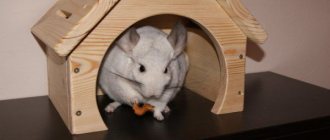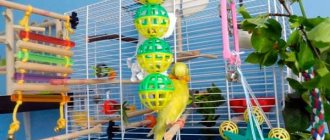- home
- Rat
- Care
06/20/2019 Every creature should have its own comfortable corner. For a rat, a cage is a place that protects from irritants and dangers. You don’t have to buy a house for a rodent: you can make it yourself. Your love for the tailed creature will help you make a home for a small pet.
How to make a rat cage
Many people have at one time or another had the desire to have a rat, but the thought prevented them from realizing their cherished dream: “What will the rat live in, where will it sleep?” Yes, it is worth noting that high-quality cages for small rodents are difficult to find on the market and even in a pet store.
Well, if there is a suitable cage somewhere, then the cost will not please you much. But don’t go astray from the intended path, because a rat cage is a simple structure, and you don’t need an engineering education to build such a mini-dwelling. A do-it-yourself rat cage is a wonderful alternative to all purchased houses. In addition, you can make it to your taste and color. And don't think about the costs. A homemade building will be much cheaper than a commercial option.
What materials can it be made from?
When planning the construction of rabbit hutches, the first thing to think about is the choice of suitable building materials. In principle, any available means are suitable for constructing a simple structure that can protect animals from unfavorable external factors.
In the construction of rabbit farms, wood and metal, galvanized profiles, plastic elements, bricks, clay and even industrial pallets are used. Despite the fact that almost any materials are suitable for use, their choice should be approached with full responsibility.
Wood
Even a novice rabbit breeder can handle making a wooden cage
Wood is used very widely in the construction of rabbit cages. Any structural elements can be made from it. It is from wooden beams that the frame of the future cage is usually made. Floors made of wooden planks are also popular among rabbit breeders.
The main advantages of the material are environmental friendliness and ease of processing . Wooden elements can be easily given almost any shape. You should not lose sight of the excellent thermal insulation properties of wood: in winter a wooden rabbitry will be warm, and in summer it will not be too hot.
Among the disadvantages, it is worth highlighting rapid destruction. Rabbits love to chew on everything around them, so the wooden elements of the interior of the cage are quickly destroyed by rodents. In addition, due to its porous structure, wood absorbs all odors and liquids, so it is not recommended to install a solid wooden floor in a cage.
Important! Insects and humidity also contribute to the rapid destruction of wood, therefore all wooden structural elements must be treated with protective compounds. When choosing such a composition, make sure it is safe for animals.
Metal
Metal is much stronger than wood, but working with it requires a different level of skill
Compared to wood, metal is a more durable material for construction . Rabbits cannot chew through metal elements, they are easy to wash and are not afraid of insects. True, metal processing requires special skills from the master, as well as the ability to handle special tools.
The frame of the future cage is created from metal pipes. Metal is also used for the interior of wooden cages to prevent the natural material from being chewed through. But it is not recommended to make the roof and outer walls of the cage from metal, since in the sun they can become very hot, and in the cold they can freeze, which can pose a threat to the health of long-eared residents.
Galvanized profile
Galvanized profiles are used in combination with other materials. Unlike all-metal elements, strengthening or finishing the cage with a profile does not make the structure heavier, which is especially important for portable mobile rabbit cages.
Plastic elements
Plastic is lightweight and durable, but can release toxic substances in the heat
Plastic pipes can be an alternative to wooden beams and metal pipes. Durable and lightweight material allows you to create universal cages for use in any conditions.
When working with plastic, it is important to keep animal safety in mind. Internal structural elements that can get in the teeth of rabbits should not be made of plastic. The animal can injure its mouth or esophagus from shrapnel, as well as be poisoned by synthetic substances included in the material.
Important! When exposed to extreme heat (for example, in the heat), some types of plastic release toxic substances.
Bricks and clay
Bricks and clay are used to build rabbit hutches mainly in hot regions . The bases for the houses are laid with bricks, and the seams are coated with clay. Such a cage protects animals well from overheating, since the brick has excellent thermal insulation properties.
Net
The walls of rabbit cages are made solid, in the form of a lattice of slats, or they are made of mesh. The most convenient option is considered to be a mesh, which should have medium or small cells and be strong enough.
Slate
The most practical material for making a roof for a rabbit hutch is slate. It will perfectly perform its protective function, without overheating in the sun and without being afraid of moisture.
Available materials
Rabbits are not the easiest animals to care for. For temporary housing or in conditions of critical savings, houses made from scrap materials are suitable. Inventive rabbit breeders adapt old barrels and containers to contain rodents, or assemble multi-story structures from industrial pallets.
Each material has special properties that can be both an advantage and a disadvantage. You should be guided in your choice based on the advice of experienced rabbit breeders, individual conditions (climate, animal breed, etc.) and instructions for popular drawings if you plan to use them.
Important stage
A rat cage is more than just a house. This is a place where the animal rests body and soul. That is why it is so important to maintain harmony when building this cage. After all, a lot depends on the rat’s house.
For example, will the pet be comfortable? That's what makes it fun. Will the little rat be playful or withdrawn? Will he live a long and happy life? When building a house, many factors need to be taken into account. Size, shape, toys, add-ons and more. Therefore, it is important to adhere to simple rules: accuracy and quality.
Theoretical beginning
If the question is asked: “How to make a cage for a rat with your own hands”? – then it’s worth starting with theory. Namely, from the outline of the diagram. After all, without a drawing, not a single carpenter will get down to business. In this case, the diagram will help take into account the materials used.
Just about them. For the job you will need wooden blocks about three centimeters thick, nails, screws and galvanized iron mesh with a diameter of no more than twenty millimeters. Rats crawl well even in the narrowest places, so holes with a large diameter will not keep the animal locked up. When constructing, you need to consider the correct size of the rat cage. The height must be at least eighty centimeters. This parameter will facilitate the construction of a second floor. In addition, rats do not like cramped spaces. The width of the cage will be at least forty centimeters. You need to place toys and tunnels somewhere. The length of the cage will not exceed seventy centimeters. With such dimensions, the animal will not feel cramped. The rat will run and frolic. A little advice. These data are given for the residence of one rat. If in the future a friend or girlfriend joins the animal, then you need to increase the area of the structure from the very beginning. Not twice, of course, but you need to add ten centimeters to the above data.
What should a cell be like? – arrangement
Metal cages are considered the most popular and convenient for keeping rats. And they are recommended for beginner rat breeders.
Just don’t rush to purchase the first model you come across. Pay attention to the quality and safety of the materials from which the cage is made. The metal must be protected from corrosion, coated with durable enamel paint or galvanized.
Make sure the ends of the rods are welded and finished thoroughly, otherwise the animal will get caught and be seriously injured. Collapsible or folding designs are preferable; they are more convenient to clean.
For keeping rats, the optimal cage size in terms of length-width-height parameters is considered to be 60x40x80 cm per one or two animals.
REFERENCE
There is a special formula for calculating how many animals can fit in a cage:
N= (a ×b×c) in cm/100000, where
N – number of rats;
a – length;
b – width;
c – height.
It is also important what gender the animals are. Males are usually larger and lazier, so horizontal models with a wide bottom are suitable for them; for females, vertical models with several tiers are suitable, since girls on average weigh less, are more mobile, and climb cages more actively.
Although some experienced rat breeders believe that the cage should correspond to the biological characteristics of the animals, and not their gender. A multi-story “skyscraper” is inconvenient and dangerous, and rats find it boring to be in a low building.
The clearance between the bars of a metal cage is acceptable within the following limits:
- 0.5-1 cm for baby rats;
- 1.5-1.7 cm for adults, for especially large males - 2 cm.
Rats are fidgety animals, they need to be given the opportunity to climb and jump. Horizontal bars in a cage work best for this. And there is no need for additional stairs. Although, if you have a young or elderly rat, stairs will make movement easier and serve as insurance against a possible fall.
Shelves on different tiers are required , with a distance between them of at least 15-20 cm, so that an adult rat can freely stand on its hind legs or jump without the risk of injury.
REFERENCE It is allowed to keep rats in cages for chinchillas and striped squirrels. Cages for guinea pigs and rabbits are less suitable; they have a large gap between the bars and are not high enough for rats.
What should be in the cage
When thinking about the interior of a rat's abode, keep in mind that all items should be made from materials that are harmless to the pet's health , firmly fixed and easily removed during cleaning.
The main elements that are installed in the cage are as follows:
- a house made of durable plastic, wood or ceramics where rats can retire, rest or simply observe;
- hammock for sleeping , preferably made of natural dense fabric, which is hung in the corner of the cage;
- bed;
- toilet in the form of a ceramic or plastic corner container.
In addition to them, other accessories are also placed:
- bowls - heavy ceramic, earthenware or glass for cereals and succulent food and hanging plastic for grain mixtures;
- ball or nipple drinker;
- mineral stone for grinding teeth and enriching the animal’s body with useful substances;
- fabric or plastic tunnels or labyrinths;
- hanging wooden or rope swing;
- stairs;
- chewing toys;
- mowing tray;
- ropes made from coconut or hemp fibers.
And that's not all. Thick branches of fruit trees, paper tubes, wicker baskets, bundles of hay and even an inverted clay flower pot are suitable for decoration. Show your imagination and create a unique style.
IMPORTANT Running wheels or walking balls are not suitable for rats. The long tail makes it difficult to run in them. If it is not possible to let the animal roam freely around the room, then it is better to walk it on a special leash (if the rat likes it).
It is better to choose a tray for the cage from durable plastic that is easy to clean. Its height should be at least 10 cm so that the filler does not scatter around the room during active digging and games. Solid wood and metal pallets are not suitable . The tree quickly accumulates bacteria and an unpleasant odor and is easily chewed by animals. The metal oxidizes and rusts, which leads to poisoning.
Fruit tree shavings, bedding made from the leafy mass of corn or hemp are suitable as filler for rats.
Practice time
A do-it-yourself rat cage should be no different from a purchased one. Therefore, you need to build conscientiously, because just give small animals a chance, and they will immediately run away. First you need to construct a wooden base that will hold its shape.
The cube must acquire the above parameters. You need to cut the blocks carefully so that there are no nicks or cracks. It is better to remove excess irregularities after finishing with a saw using medium-grit sandpaper. So the edges will not be sharp, and the building will take on a completely new, neat look. Before moving on to another stage of work, it is worth taking care of the tree. It needs to be processed somehow. Ordinary construction varnish works great. You need to varnish in two steps. The first time, the wooden parts need to be well varnished and dried. The second time, for reliability, the wood should be varnished again, but with a thinner layer. The wooden frame has dried - then you need to move on to the next stage.
Cage for decorative rabbits
In addition to the covered part, a cage for decorative rabbits must have an open part.
The more spacious the home for a decorative rabbit, the better. Animal comfort is also provided by the construction of two-story structures or enclosures for walking. Decorative rabbits, as a rule, are kept indoors, so the requirements for thermal insulation and protection from external factors for the design of the home are much lower .
The flooring in a cage for decorative breeds of rabbits should be solid and soft. The surface of the paws of decorative rodents is prone to inflammation and deformation, since it does not have soft pads. The ideal option is a wooden floor covered with soft absorbent material (sawdust, special wood filler, soft straw, absorbent diapers, etc.).
Required tools and materials
Making a cage for keeping decorative rabbits involves using the following materials:
- Sheets of plywood, chipboard or wooden panels: it is better to take extra, focusing on the dimensions of the cage (90x60x45 cm);
- Metal sheet (tin can be used): 90x60 cm;
- Wooden slats;
- Metal mesh: 60x45 cm minimum;
- Self-tapping screws or nails;
- Door fittings.
Tools for work:
- Saw, hacksaw or jigsaw;
- Screwdriver or hammer;
- Nippers or metal scissors;
Drawing
Drawing of a multi-tiered cage for decorative rabbits
The dimensions in the drawing are indicated in centimeters. The size and design of the cage are optimal for keeping one adult individual in a heated room.
Manufacturing instructions
- The construction of a cage for a decorative rabbit begins from the floor. A base measuring 90x60 cm is cut out of chipboard or a wooden board.
- A metal shield of similar dimensions is placed on a wooden base.
- Then, boards for walls measuring 45x60 cm are prepared from wood or chipboard.
- The frame is assembled using nails or self-tapping screws.
- The door is made of wooden slats and metal mesh. The optimal size for the door is 30x30 cm.
- The second tier is made of the same material as the walls and is installed inside the cage.
- The staircase is made of slats, maintaining a width of at least 15 cm, and is installed close to the second tier, carefully securing it.
Making a cage for keeping decorative rabbits is quite simple. Even novice rabbit breeders who have no experience in construction and design can cope with the task. You should not paint the surfaces of the cage with paints and varnishes, as rodents can be poisoned by toxic substances by gnawing on structural elements.
Video: DIY two-story rabbit cage
Working with galvanized mesh
In addition to the frame, the rat cage must also contain a lattice, which, in fact, will keep the animal locked up. Otherwise, the apartment of the happy owner will be in chaos and destruction. Just like any house, a cage consists of four walls, a floor and a ceiling. Almost everything except the pallet will be created from galvanized mesh. And this means that you have to work hard. First you need to mark the walls. They should be as tall and wide as a frame. That is, everything should fit together perfectly. The marks have been set - let's get to work. To cut the mesh accurately, you need good and sharp tools.
Wire cutters are suitable for this task. Galvanized mesh must be cut step by step, section by section. You constantly need to measure what is cut off: parallel walls must be the same. Otherwise, the cell will bend in different directions like a wave. But this will not increase comfort in any way, and the appearance will be sloppy. Well, if the walls are already cut, they should be prepared for further use. First, sand down all edges, tips and nicks. Protruding shoots should also be removed. Sanding work can be done with sandpaper. He will do this task well. Secondly, the cut galvanized mesh needs to be painted. This will protect the cage from rusting and from quickly losing its presentation. You can paint the mesh with regular enamel.
Required funds
The main material for a homemade house is wood: it absorbs bad odors well. Inexpensive plywood, boards or chipboards are easy to process, safe and last a long time. However, wood is not the best option for rats. Rodents love to chew on wooden structures, and the cage will not last long.
A good choice would be a structure made of mesh or rods. Galvanized or enameled metal does not give in to rat teeth and rust. To assemble the parts you need a soldering iron, flexible wire and the following tools:
- Roulette;
- Markers;
- Ruler;
- Nippers and pliers;
- Hammer;
- Metal scissors;
- File.
A homemade rat cage needs a base - a tray. It should be easy to clean and not leak liquid. A plastic tray of the required size or one made from PVC leaves will do. To attach the joints you will need silicone glue. The rest of the materials and tools are sold at the hardware store, including gloves for work.
When selecting a mesh, take into account the size of the cells so that the rodent does not crawl out through them.
If you decide to make a cage from scrap materials using wood, old furniture - a closet or shelves - will help you.
Work on the pallet
The tray is an important part of the entire cell. It is on it that the animal will sleep and rest, go to the toilet on it, and eat on it. Here you really need to try. The bottom of the cage will consist of PVC sheets.
As a last resort, you can use plywood. Again, the parts of the pallet must match the length and width of the frame. It is better to cut PVC sheets with a hacksaw; it will not leave large nicks.
DIY rat masterpiece
After the drawing, preparation of the workplace begins. You can make a frame by bending the mesh or cutting out parts for fastening. The work stand will be a flat, hard surface protected from damage.
Making a metal masterpiece for a rat includes the following steps:
- When bending the cage, the drawing is performed as a single development. The parts are cut out with scissors and the folds are marked.
- You can bend the mesh evenly in the following way. The material must be placed on the edge of a hard surface, pressed with a board and hit with a hammer several times along the marked fold line.
- Other parts for assembly are cut out with scissors according to the drawing, and the edges are filed with a file so that the rats do not get hurt.
- The roof and walls are connected with pieces of wire 40-50 mm long. To do this, the wire is joined in half, fastening the two parts, and the ends are wrapped around the connected rods. The protruding ends are pressed with pliers and sharpened with a file.
- Holes for doors in the shape of squares are cut out in the walls (on the roof and floors).
- Doors and shelves are made from separate pieces and attached to the walls with flexible wire. For variety, you can put ladders between floors;
- Door locks are made from a bent piece of wire, a metal plate or a clamp.
Door lock made from a paper clip
The frame of a large cage can be strengthened with a metal corner profile, and holes can be drilled in its walls to attach the mesh to bolts or wire. Such a frame can easily withstand heavy weight.
After the frame comes the turn of the pallet. Its dimensions are checked twice to eliminate errors. For manufacturing you will need a PVC sheet 4-5 mm thick. The base is cut from the sheet, slightly larger than the frame, and the edges are 100-150 mm high. The sides are glued to the base and secured at the corners, and the joints are coated with silicone.










